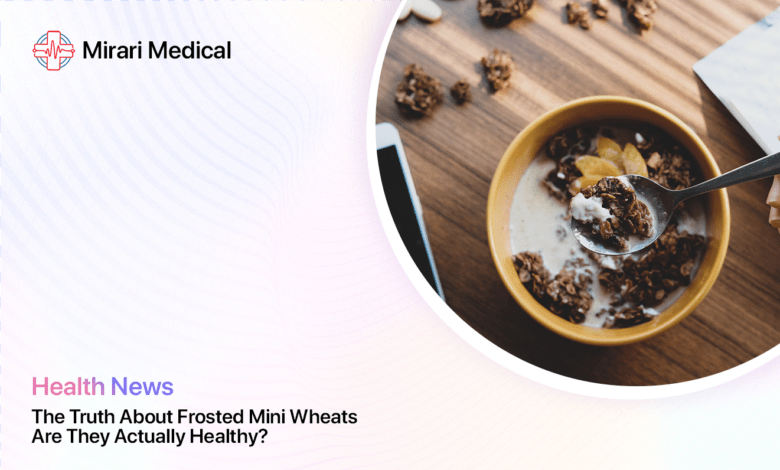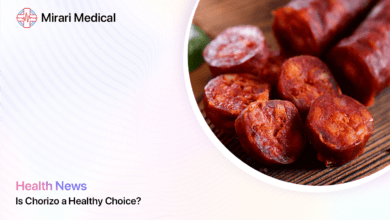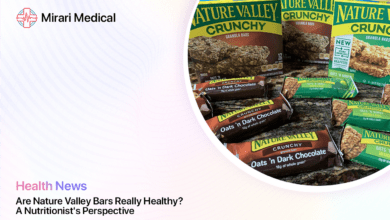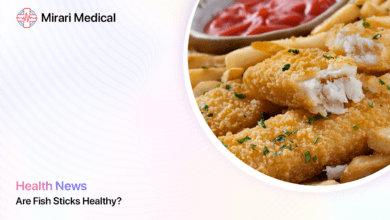The Truth About Frosted Mini Wheats: Are They Actually Healthy?

You may be interested
- Hash Browns: Are They Really Healthy?
- Is Cream of Wheat Healthy for You? Exploring the Nutritional Benefits and Drawbacks
- Are Nature Valley Bars Really Healthy? A Nutritionist’s Perspective
- Unveiling the Truth: Are Grape Nuts Really a Healthy Choice?
- Unveiling the Truth: Are Honey Bunches of Oats Really Healthy?
Did you know that Americans consume over 2.7 billion boxes of cereal annually? That’s enough to wrap around the world 13 times! Among these popular breakfast options, Frosted Mini-Wheats have carved out a significant niche. But as health-conscious consumers, we often wonder: are these tasty morsels actually good for us?
In this comprehensive guide, we’ll dive deep into the world of Frosted Mini-Wheats, exploring their nutritional profile, potential health benefits, and possible drawbacks. We’ll uncover the truth behind this popular breakfast cereal and help you make an informed decision about including it in your diet.
Whether you’re a long-time fan of Frosted Mini-Wheats or just curious about their nutritional value, this article will provide you with all the information you need. So grab a bowl (of cereal or not), and let’s embark on this crunchy journey to uncover the truth about Frosted Mini-Wheats.
What Are Frosted Mini Wheats?
Frosted Mini-Wheats are a popular breakfast cereal manufactured by Kellogg’s. They consist of small, rectangular biscuits made from shredded whole grain wheat, with one side coated in a sweet frosting. This unique combination gives the cereal its signature taste and texture – a perfect balance of wholesome wheat and sugary sweetness.
The cereal was first introduced in the United States in 1969, initially as a larger-sized biscuit. The smaller, bite-sized version we know today was launched in 1980. Since then, Frosted Mini-Wheats have become a breakfast staple in many households, loved by both children and adults alike.
What sets Frosted Mini-Wheats apart from other cereals is their simple ingredient list. The main components are:
- Whole grain wheat
- Sugar
- Brown rice syrup
- Gelatin
- BHT (for freshness)
Additionally, the cereal is fortified with various vitamins and minerals, which we’ll discuss in more detail later.
One of the key selling points of Frosted Mini-Wheats is their high whole grain content. Each serving provides 41 grams of whole grains, which is a significant portion of the recommended daily intake. Whole grains are an essential part of a healthy diet, providing fiber, vitamins, minerals, and other beneficial plant compounds.
Frosted Mini-Wheats come in several flavors, including:
- Original
- Strawberry
- Blueberry
- Cinnamon Roll
- Chocolate
Each flavor variation maintains the basic wheat biscuit structure but offers a different frosting flavor to cater to various taste preferences.
In the next section, we’ll take a closer look at how these crunchy biscuits are made, giving you a behind-the-scenes peek at the production process of Frosted Mini-Wheats.
How Are Frosted Mini Wheats Made?
The production process of Frosted Mini-Wheats is a fascinating blend of traditional cereal-making techniques and modern food technology. Let’s walk through the steps:
- Wheat Preparation: The process begins with whole grain wheat kernels. These kernels are cleaned and then cooked in water and steam for about 30 minutes. This cooking process softens the wheat and prepares it for the next stage.
- Drying: After cooking, the wheat is dried to reduce its moisture content. This is done using hot air, which brings the moisture level down to the perfect consistency for shredding.
- Shredding: This is where the magic happens! The cooked and dried wheat is fed into machines with special rollers. These rollers shred the wheat into fine, delicate strands. Multiple layers of these shredded wheat strands are then laid on top of each other to form the characteristic texture of the cereal.
- Cutting: The layered sheets of shredded wheat are then cut into the small, rectangular biscuits we recognize as Mini-Wheats.
- Baking: The cut biscuits are baked in large ovens. This baking process gives the cereal its crispy texture and toasty flavor.
- Frosting: After baking, one side of each biscuit is sprayed with a sugar solution that forms the frosting. This is done while the biscuits are still warm, allowing the frosting to set properly.
- Cooling and Packaging: Finally, the frosted biscuits are cooled and then packaged into boxes for distribution.
Throughout this process, quality control measures are in place to ensure consistency in size, texture, and taste. The entire production is automated, with machines handling everything from the initial cooking of the wheat to the final packaging of the cereal.
It’s worth noting that the exact details of the production process, especially the frosting application, are closely guarded trade secrets. Kellogg’s has perfected this process over decades to create the unique texture and taste that Frosted Mini-Wheats are known for.
One interesting aspect of the production is the use of BHT (Butylated Hydroxytoluene) as a preservative. This is added to the packaging, not the cereal itself, to help maintain freshness by preventing oxidation of the oils in the whole grain wheat.
The fortification process, where vitamins and minerals are added to the cereal, typically occurs after the baking stage. This ensures that these important nutrients are not destroyed by the high temperatures used in baking.
Understanding how Frosted Mini-Wheats are made gives us a better appreciation of what goes into our breakfast bowl. In the next section, we’ll delve into the nutritional profile of this popular cereal to see what benefits it might offer.
What Are the Nutritional Values of Frosted Mini Wheats?
To truly understand whether Frosted Mini-Wheats are healthy, we need to take a close look at their nutritional profile. Let’s break it down into two main categories: macronutrients (calories, carbohydrates, protein, and fat) and micronutrients (vitamins and minerals).
1. Calories and Macronutrients
Here’s a breakdown of the macronutrients in a typical serving of Frosted Mini-Wheats (25-27 biscuits or about 51 grams):
| Nutrient | Amount | % Daily Value |
|---|---|---|
| Calories | 210 | – |
| Total Carbohydrates | 51g | 19% |
| Dietary Fiber | 6g | 21% |
| Total Sugars | 12g | – |
| Added Sugars | 12g | 24% |
| Protein | 5g | – |
| Total Fat | 1.5g | 2% |
| Saturated Fat | 0g | 0% |
| Trans Fat | 0g | – |
As we can see, Frosted Mini-Wheats are primarily a carbohydrate-based food, with a significant amount of fiber and a moderate amount of protein. They’re low in fat, which is a plus for those watching their fat intake.
The sugar content is something to note – with 12 grams of added sugar per serving, it accounts for 24% of the recommended daily limit for added sugars. This is one of the main concerns when considering the healthiness of Frosted Mini-Wheats.
2. Vitamins and Minerals
One of the strengths of Frosted Mini-Wheats is their vitamin and mineral content. Here’s a look at the micronutrients provided in a single serving:
| Vitamin/Mineral | Amount | % Daily Value |
|---|---|---|
| Iron | 18mg | 100% |
| Folate | 400mcg | 100% |
| Vitamin B1 (Thiamin) | – | 10% |
| Vitamin B2 (Riboflavin) | – | 10% |
| Vitamin B3 (Niacin) | – | 10% |
| Vitamin B6 | – | 10% |
| Zinc | – | 10% |
| Magnesium | – | 10% |
| Phosphorus | – | 10% |
As we can see, Frosted Mini-Wheats are an excellent source of iron and folate, providing 100% of the daily value for both these essential nutrients. They also provide significant amounts of various B vitamins and minerals.
It’s important to note that these values are for the cereal alone. When consumed with milk, as many people do, the nutritional profile changes. For example, adding 3/4 cup of skim milk increases the calorie count to 270 and boosts the protein content to 11 grams.
The high fiber content (6 grams per serving) is another notable aspect of Frosted Mini-Wheats‘ nutritional profile. Fiber is crucial for digestive health and can help with feelings of fullness and satiety.
In the next section, we’ll analyze these nutritional facts to determine whether Frosted Mini-Wheats can be considered a healthy breakfast option.
Are Frosted Mini Wheats Healthy?
Now that we’ve examined the nutritional profile of Frosted Mini-Wheats, let’s assess whether they can be considered a healthy breakfast option. As with many foods, there are both pros and cons to consider.
1. High in Fiber
One of the most significant health benefits of Frosted Mini-Wheats is their high fiber content. With 6 grams of fiber per serving, this cereal provides 21% of the daily recommended intake for adults. Fiber is crucial for several reasons:
- It aids in digestion and helps prevent constipation
- It can help lower cholesterol levels
- It promotes feelings of fullness, which can aid in weight management
- It helps regulate blood sugar levels
The high fiber content is primarily due to the whole grain wheat used in Frosted Mini-Wheats. Whole grains are an essential part of a healthy diet, and the American Heart Association recommends making at least half of your grain intake whole grains.
2. Low in Fat and Sodium
Frosted Mini-Wheats are very low in fat, with only 1.5 grams per serving, and contain no saturated or trans fats. This makes them a good option for those watching their fat intake or trying to maintain heart health.
Additionally, they’re very low in sodium, with only 10 mg per serving. This is excellent news for those monitoring their sodium intake, as many processed foods are high in salt.
3. Fortified with Vitamins and Minerals
Like many breakfast cereals, Frosted Mini-Wheats are fortified with essential vitamins and minerals. They’re an excellent source of iron and folate, providing 100% of the daily value for both these nutrients. Iron is crucial for transporting oxygen in the blood, while folate is essential for cell growth and function.
The cereal also provides significant amounts of B vitamins, zinc, magnesium, and phosphorus. These nutrients play various roles in the body, from energy metabolism to immune function and bone health.
However, it’s important to note that while fortification can be beneficial, it’s generally better to get nutrients from whole food sources when possible.
Despite these health benefits, there are some concerns about Frosted Mini-Wheats that we need to address:
- High in Added Sugar: Each serving contains 12 grams of added sugar, which is 24% of the daily recommended limit. Regular consumption of high-sugar foods can contribute to various health issues, including obesity and tooth decay.
- Processed Food: While made from whole grain wheat, Frosted Mini-Wheats are still a processed food. The wheat has been significantly altered from its natural state, and additional ingredients like sugar and preservatives have been added.
- Calorie Density: At 210 calories per serving, Frosted Mini-Wheats are relatively calorie-dense. This could be a concern for those watching their calorie intake.
In conclusion, while Frosted Mini-Wheats do offer some nutritional benefits, particularly in terms of fiber and fortified nutrients, they also come with some drawbacks, primarily their high sugar content. Whether they can be considered “healthy” depends on individual nutritional needs and how they fit into one’s overall diet.
In the next section, we’ll delve deeper into the potential health risks associated with consuming Frosted Mini-Wheats.
What Are the Potential Health Risks of Eating Frosted Mini Wheats?
While Frosted Mini-Wheats do offer some nutritional benefits, it’s important to be aware of potential health risks associated with regular consumption. Let’s explore these concerns in more detail.
1. High in Added Sugar
The most significant health concern with Frosted Mini-Wheats is their high sugar content. Each serving contains 12 grams of added sugar, which is 24% of the daily recommended limit set by the American Heart Association.
Consuming too much added sugar can lead to several health issues:
- Weight Gain: Excess sugar intake can contribute to weight gain and obesity, which are risk factors for various health problems.
- Increased Risk of Type 2 Diabetes: High sugar consumption can lead to insulin resistance over time, increasing the risk of developing type 2 diabetes.
- Dental Health Issues: Sugar is a primary cause of tooth decay and cavities.
- Heart Disease: High sugar intake has been linked to an increased risk of heart disease.
- Nutrient Displacement: When we consume a lot of sugary foods, we may be less likely to eat nutrient-dense foods, potentially leading to nutrient deficiencies.
It’s worth noting that the sugar in Frosted Mini-Wheats comes from the frosting, not the wheat itself. The unfrosted side of the cereal is essentially just whole grain wheat.
2. May Contain Harmful Ingredients
While the ingredient list for Frosted Mini-Wheats is relatively short compared to many processed foods, there are a couple of items that some consumers might be concerned about:
- BHT (Butylated Hydroxytoluene): This preservative is added to the packaging to maintain freshness. While it’s generally recognized as safe by the FDA, some studies have raised concerns about its potential health effects.
- Gelatin: This is used in the frosting and may be a concern for vegetarians or those following certain religious dietary restrictions, as it’s typically derived from animal sources.
3. Potential for Overconsumption
The sweet taste and crunchy texture of Frosted Mini-Wheats can make them quite addictive. It’s easy to eat more than the recommended serving size, especially when snacking directly from the box. This can lead to excessive calorie and sugar intake.
4. Processed Nature
While Frosted Mini-Wheats are made from whole grain wheat, they are still a processed food. The wheat has been significantly altered from its natural state, and additional ingredients have been added. Some nutrition experts argue that it’s best to limit processed foods in favor of whole, minimally processed options.
5. Gluten Content
For individuals with celiac disease or gluten sensitivity, Frosted Mini-Wheats are not a suitable option as they contain wheat, which is a source of gluten.
6. Potential for Nutrient Imbalance
While Frosted Mini-Wheats are fortified with various vitamins and minerals, relying too heavily on fortified foods can potentially lead to imbalances in nutrient intake. It’s generally recommended to get most of your nutrients from a variety of whole food sources.
It’s important to remember that these potential risks don’t mean Frosted Mini-Wheats can’t be part of a healthy diet. The key, as with many foods, is moderation and balance. In the next section, we’ll explore how Frosted Mini-Wheats might fit into a weight loss plan, despite some of these concerns.
Can Frosted Mini Wheats Help with Weight Loss?
When it comes to weight loss, Frosted Mini-Wheats present a bit of a paradox. On one hand, they contain added sugar and are relatively high in calories for a cereal. On the other hand, they have some properties that could potentially aid in weight management. Let’s break it down:
1. High in Fiber and Protein
One of the most significant benefits of Frosted Mini-Wheats for weight loss is their high fiber content. Each serving provides 6 grams of fiber, which is 21% of the daily recommended intake. Fiber is crucial for weight loss for several reasons:
- It promotes feelings of fullness, which can help reduce overall calorie intake
- It slows down digestion, helping to stabilize blood sugar levels and prevent sudden hunger spikes It can help lower cholesterol levels, which is beneficial for overall health and can indirectly support weight management efforts.
Additionally, Frosted Mini-Wheats provide 5 grams of protein per serving. While this isn’t as high as some protein-focused cereals, it’s still a decent amount. Protein, like fiber, can help increase satiety and reduce overall calorie intake throughout the day.
2. Low in Calories
Compared to many other breakfast options, Frosted Mini-Wheats are relatively low in calories. A serving of 25-27 biscuits contains about 210 calories. When paired with low-fat or skim milk, this can make for a filling breakfast under 300 calories.
However, it’s crucial to be mindful of portion sizes. It’s easy to pour more than one serving into a bowl, which can quickly double the calorie count.
3. May Help with Satiety
The combination of fiber, protein, and whole grains in Frosted Mini-Wheats can contribute to feelings of fullness and satisfaction after eating. This satiety factor is crucial for weight loss, as it can help prevent overeating later in the day.
A study published in the Journal of the American Dietetic Association found that people who ate cereal for breakfast felt less hungry and ate fewer calories at lunch compared to those who ate a higher-fat breakfast or skipped breakfast altogether.
However, it’s important to note some potential drawbacks:
- Sugar Content: The 12 grams of added sugar per serving could potentially counteract some of the weight loss benefits. Consuming too much added sugar can lead to blood sugar spikes and crashes, which might increase hunger and cravings.
- Processed Nature: As a processed food, Frosted Mini-Wheats may not be as satisfying or nutritionally complete as whole food options like oatmeal with fresh fruit.
- Calorie Density: While not extremely high in calories, Frosted Mini-Wheats are more calorie-dense than some other breakfast options like plain oatmeal or fresh fruit.
If you’re considering incorporating Frosted Mini-Wheats into a weight loss plan, here are some tips:
- Stick to the recommended serving size
- Pair with low-fat or skim milk to add protein without significantly increasing calories
- Add fresh fruit for extra fiber and nutrients without many added calories
- Consider mixing Frosted Mini-Wheats with a lower-sugar, high-fiber cereal to reduce overall sugar intake while maintaining the satisfying crunch and sweetness
Remember, weight loss is about overall calorie balance and nutrient quality. While Frosted Mini-Wheats can be part of a weight loss diet, they should be consumed as part of a balanced eating plan that includes a variety of whole, nutrient-dense foods.
In the next section, we’ll explore how to incorporate Frosted Mini-Wheats into a healthy diet in a way that maximizes their benefits while minimizing potential drawbacks.
How to Incorporate Frosted Mini Wheats into a Healthy Diet?
While Frosted Mini-Wheats have both nutritional benefits and potential drawbacks, they can be part of a healthy diet when consumed mindfully. Here are some strategies for incorporating this popular cereal into a balanced eating plan:
1. Choose Whole Grain Options
Frosted Mini-Wheats are made from whole grain wheat, which is a plus. Whole grains provide more fiber, vitamins, and minerals than refined grains. When selecting cereals, always opt for those that list a whole grain as the first ingredient, as Frosted Mini-Wheats do.
2. Limit Portion Sizes
One of the easiest ways to make Frosted Mini-Wheats fit into a healthy diet is to be mindful of portion sizes. Stick to the recommended serving size of 25-27 biscuits (about 51 grams). Using a measuring cup or kitchen scale can help ensure you’re not inadvertently overeating.
3. Pair with Nutritious Foods
To boost the nutritional value of your breakfast, consider pairing Frosted Mini-Wheats with other healthy foods:
- Add fresh fruit like berries or sliced banana for extra fiber, vitamins, and natural sweetness
- Use low-fat or skim milk to increase protein content without adding too many calories
- Sprinkle some nuts or seeds on top for healthy fats and additional protein
- Mix with plain, unsweetened whole grain cereal to reduce the overall sugar content while maintaining some of the sweet taste
4. Balance Throughout the Day
If you enjoy Frosted Mini-Wheats for breakfast, balance out the added sugar by limiting sugary foods for the rest of the day. Focus on whole, unprocessed foods for your other meals and snacks.
5. Use as a Topping or Snack
Instead of having a full bowl of Frosted Mini-Wheats, consider using them as a topping for yogurt or as a small snack. This allows you to enjoy their taste and crunch while limiting your intake.
6. Consider Timing
Some nutritionists suggest that it’s better to consume higher-sugar foods earlier in the day when you’re more likely to be active and burn off the energy. Having Frosted Mini-Wheats for breakfast or as a pre-workout snack might be preferable to eating them late at night.
7. Look for Lower Sugar Varieties
Kellogg’s offers some varieties of Mini-Wheats with less sugar. For example, their “Little Bites” version has slightly less sugar per serving. Always check the nutrition label to compare options.
8. Stay Hydrated
Drinking water with your cereal can help you feel full and potentially eat less. It’s also important for overall health and can help counteract the effects of the added sugar in Frosted Mini-Wheats.
9. Use as Part of a Balanced Diet
Remember that no single food determines the healthiness of your diet. It’s the overall pattern of eating that matters most. Frosted Mini-Wheats can be part of a healthy diet when balanced with a variety of other nutritious foods throughout the day.
10. Listen to Your Body
Pay attention to how you feel after eating Frosted Mini-Wheats. If you find that you’re hungry soon after or experience energy crashes, you might want to consider alternative breakfast options or ways to modify your Frosted Mini-Wheats meal to make it more satisfying and nutritionally balanced.
By following these strategies, you can enjoy Frosted Mini-Wheats as part of a healthy, balanced diet. Remember, moderation and variety are key to any healthy eating plan.
FAQs
Are frosted mini-wheats good for you?
Frosted Mini-Wheats have both positive and negative aspects when it comes to nutrition. On the positive side, they’re high in fiber (6 grams per serving), made from whole grain wheat, and fortified with essential vitamins and minerals. They’re also low in fat and sodium. However, they’re high in added sugar (12 grams per serving), which is a significant drawback. Whether they’re “good for you” depends on your individual nutritional needs and how they fit into your overall diet. For most people, they can be part of a healthy diet when consumed in moderation and balanced with other nutritious foods.
Do mini-wheats have any nutritional value?
Yes, Mini-Wheats do have nutritional value. They’re a good source of fiber, providing 6 grams per serving, which is 21% of the daily recommended intake. They’re made from whole grain wheat, which offers various nutrients. Additionally, they’re fortified with several vitamins and minerals, including iron (100% DV), folate (100% DV), and various B vitamins (10% DV each). They also provide 5 grams of protein per serving. However, it’s important to note that they also contain 12 grams of added sugar per serving, which is a significant amount.
Why do people like frosted mini-wheats?
People enjoy Frosted Mini-Wheats for several reasons:
- Taste: The combination of crunchy wheat and sweet frosting creates a satisfying flavor and texture.
- Convenience: They’re quick and easy to prepare, making them a popular breakfast choice.
- Perceived healthiness: The whole grain content and fortification with vitamins and minerals make them seem like a healthier choice compared to some other cereals.
- Versatility: They can be eaten with milk, used as a topping for yogurt, or eaten as a dry snack.
- Nostalgia: For many, they’re a childhood favorite that brings back fond memories.
- Satiety: The fiber and protein content can help people feel full and satisfied.
How good are mini-wheats?
The “goodness” of Mini-Wheats depends on various factors:
- Nutritional content: They’re high in fiber and fortified with vitamins and minerals, which is positive. However, they’re also high in added sugar.
- Taste: Many people find them delicious, which can make them an enjoyable part of a balanced diet.
- Convenience: They’re easy to prepare, which can be beneficial for busy mornings.
- Versatility: They can be used in various ways, not just as a cereal with milk.
- Comparison to alternatives: Compared to many other breakfast cereals, they have a better nutritional profile due to their whole grain content and lower sugar content than some heavily sweetened cereals.
Overall, while not perfect, Mini-Wheats can be a decent choice when consumed as part of a balanced diet and in appropriate portions.
What is the healthiest cereal?
The “healthiest” cereal can vary depending on individual nutritional needs, but generally, the healthiest cereals tend to have these characteristics:
- High in fiber (at least 3 grams per serving)
- Low in added sugar (less than 6 grams per serving)
- Made from whole grains
- Fortified with essential vitamins and minerals
- Moderate in calories
Some cereals that are often considered healthy options include:
- Plain oatmeal
- Bran flakes
- Shredded wheat (without frosting)
- Grape-Nuts
- Cheerios (plain)
- Kashi GoLean
Remember, the healthiest cereal for you depends on your personal nutritional needs and health goals. It’s always a good idea to read nutrition labels and ingredient lists when choosing a cereal.
Are frosted flakes healthy?
Frosted Flakes, while popular, are generally not considered a healthy cereal choice. Here’s why:
- High in sugar: A serving of Frosted Flakes contains about 12 grams of added sugar, which is 24% of the daily recommended limit.
- Low in fiber: They only provide about 1 gram of fiber per serving, which is much lower than many healthier cereal options.
- Made from refined grains: Unlike Frosted Mini-Wheats, Frosted Flakes are made from corn, not whole grain wheat.
- Low in protein: They only provide about 1 gram of protein per serving.
- Fortified with vitamins and minerals: This is one positive aspect, as they do provide some essential nutrients through fortification.
While they’re not the worst option available, there are many cereals that offer better nutritional profiles. If you enjoy the taste of Frosted Flakes, consider having them as an occasional treat rather than a daily breakfast, or mix them with a healthier, high-fiber cereal to improve the overall nutritional value of your breakfast.
Takeaways
- Frosted Mini-Wheats offer both nutritional benefits and potential drawbacks. They’re high in fiber and fortified with essential vitamins and minerals, but also contain a significant amount of added sugar.
- The whole grain content of Frosted Mini-Wheats is a positive aspect, providing important nutrients and contributing to the cereal’s high fiber content.
- The high sugar content (12 grams per serving) is the main nutritional concern with Frosted Mini-Wheats.
- When incorporated mindfully into a balanced diet, Frosted Mini-Wheats can be part of a healthy eating plan. Key strategies include portion control and pairing with other nutritious foods.
- For weight management, the fiber and protein content of Frosted Mini-Wheats can contribute to feelings of fullness, but the high sugar content could potentially counteract some of these benefits.
- Compared to many other breakfast cereals, Frosted Mini-Wheats have a better nutritional profile due to their whole grain content and fortification with vitamins and minerals.
- Individual nutritional needs and overall dietary patterns should be considered when deciding whether to include Frosted Mini-Wheats in your diet.
- Always read nutrition labels and be aware of serving sizes when consuming any processed foods, including breakfast cereals.
Remember, no single food determines the healthiness of your diet. It’s the overall pattern of eating that matters most. If you enjoy Frosted Mini-Wheats, you can likely continue to include them in your diet by being mindful of portion sizes and balancing them with a variety of other nutritious foods throughout the day.
Your trusted source for health info, offering expert advice, news, and tips to stay healthy and informed.





